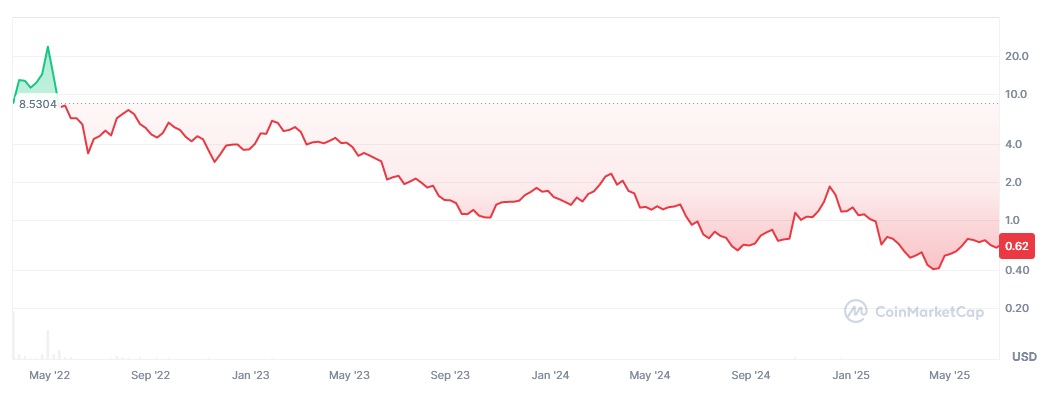ApeCoin Price Prediction 2025-2030

Wondering where ApeCoin might be headed over the next few years? This article looks at its history, strengths and weaknesses, and gives price forecasts through different scenarios.
ApeCoin (APE) is a cryptocurrency closely associated with the Bored Ape Yacht Club (BAYC), one of the most prominent non-fungible token (NFT) projects in the blockchain space. Since launch, it has experienced significant price fluctuations. This article examines the fundamentals of ApeCoin, reviews historical price performance and provides forecasts for the period 2025-2030 under several scenarios.
Note, however, that cryptocurrency prices are influenced by numerous unpredictable factors, making price predictions inherently uncertain. Therefore, readers are advised to treat such forecasts cautiously and perform their own research before making investment choices.
What is ApeCoin (APE)?
ApeCoin is a crypto token used for payments and access within projects connected to the Bored Ape Yacht Club. It also lets holders vote on decisions made by the ApeCoin DAO, a group that manages how the project moves forward.
ApeCoin's founders and history
ApeCoin (APE) was launched on March 17, 2022 by the ApeCoin DAO, a decentralized autonomous organization formed to manage and support the growth of the token and its associated ecosystem. Although ApeCoin DAO oversees the project, the token is strongly tied to Yuga Labs, the company behind the Bored Ape Yacht Club (BAYC), a prominent NFT collection. Yuga Labs did not directly issue ApeCoin but has supported its use across projects.
To support the DAO's operations, a special council known as the "ApeCoin DAO Board" was created. The board consists of prominent figures from the crypto, tech, and NFT spaces, including co-founder of Reddit Alexis Ohanian and president of Horizen Labs Dean Steinbeck.
The legal entity that supports the ApeCoin DAO and oversees the administration of the token is the Ape Foundation. It's responsible for managing funds, executing DAO-approved proposals, and ensuring the long-term growth of the ecosystem.
Upon launch, 1 billion APE tokens were created. 15% of these were distributed via airdrop to NFT BAYC and Mutant Ape Yacht Club (MAYC) holders. The rest were distributed to the DAO treasury, and various contributors with set vesting schedules.
Within 24 hours of launch, ApeCoin was listed on major cryptocurrency exchanges such as Binance, Coinbase, and Kraken, which gave it immediate liquidity and visibility.
ApeCoin overview
ApeCoin's ecosystem is a network of projects, applications, and communities that use or support the APE token. It includes NFT collections, metaverse platforms, Web3 games, and developer initiatives. The structure is centered around ApeCoin DAO, which controls the governance process and funding decisions through proposals and community votes.
Core components of the ecosystem:
- ApeCoin DAO. The DAO governs the ecosystem. It manages the community treasury, approves grants, and decides on protocol updates. Any APE holder can submit a proposal, and voting power is based on the number of tokens held.
- Bored Ape Yacht Club (BAYC). Although ApeCoin DAO is separate from Yuga Labs, the BAYC and its related NFT collections (Mutant Ape Yacht Club, Bored Ape Kennel Club) are a major part of the ecosystem.
- Otherside. Otherside is a virtual world created by Yuga Labs. APE is the primary currency for transactions within the platform, including land purchases and in-game services.
- Third-party applications and services. Several games and services have integrated ApeCoin, such as a play-to-earn mobile game Benji Bananas and an NFT marketplace OpenSea.
- Grants and funding initiatives. The DAO allocates APE tokens to fund development proposals, marketing campaigns, events and tools that support the ecosystem. These funds come from the treasury, which has received a significant portion of the total token supply.
Developers can apply for funding to build tools, applications, or services that use APE. The community is encouraged to propose and vote on such initiatives, making participation open but dependent on DAO approval. This structure is intended to support ongoing use and practical applications of the token.
ApeCoin (APE) token
ApeCoin (APE) is an ERC-20 token built on the Ethereum blockchain. It serves multiple functions within the ApeCoin DAO ecosystem:
- Governance. ApeCoin is used as a governance token within the ApeCoin DAO. Holders of APE can participate in decision-making processes, such as voting on proposals, funding allocations, and ecosystem development.
- Payments. APE can be used to purchase digital and physical goods or services within the ecosystem.
- In-game currency. APE is used as a currency in games like Benji Bananas and the Otherside metaverse.
- Access. Holding APE may grant access to exclusive events, content, or experiences within the BAYC ecosystem.
- Incentives. Developers building on the ecosystem may receive APE grants or rewards, encouraging growth and integration.

APE price statistics (as of 30/06/25)
| Parameter | Value |
|---|---|
| Current price | $0.62 |
| Market cap | $467.93M |
| Circulating supply | 752.65M APE (75,26%) |
| Max. supply | 1B APE |
| Daily trading volume | $29.91M |
| All-time high | $39.40 (17/03/22) |
| All-time low | $0.3545 (07/04/25) |
Advantages and disadvantages of ApeCoin
ApeCoin has several strengths, but it also faces a number of significant risks.
Key advantages of ApeCoin
- Ecosystem backing. ApeCoin is tied to the Bored Ape Yacht Club, one of the most successful and culturally significant NFT projects. Yuga Labs' reputation and ongoing development of new projects can drive further adoption of ApeCoin.
- Utility within the ecosystem. ApeCoin serves as the native currency of the BAYC ecosystem, used for transactions, governance, and exclusive access to events, merchandise, and digital assets.
- DAO governance. APE holders can influence the direction of the project through voting.
- Fixed supply. ApeCoin has a total supply of 1 billion tokens, with no option for further issuance. This can help maintain scarcity over time.
- Interoperability. As an ERC-20 token, APE is compatible with Ethereum-based platforms, wallets, and dApps, which increases its flexibility and utility across various systems.
- Incentives for developers. Through the ApeCoin DAO, developers can apply for grants to build tools, integrations, or services that use APE. This encourages ecosystem growth without relying solely on internal development.
Key disadvantages of ApeCoin
- Dependence on BAYC ecosystem success. ApeCoin's value is closely tied to the success of the BAYC ecosystem and Yuga Labs' projects. If the popularity of BAYC NFTs declines, or if the Otherside metaverse fails to attract users, ApeCoin's utility and value could suffer.
- Limited use case beyond the BAYC ecosystem. While ApeCoin has utility within the BAYC ecosystem, its use case outside of this ecosystem is currently limited. If it fails to gain broader adoption, its long-term value proposition could be weak compared to more versatile cryptocurrencies.
- Market saturation and competition. The NFT and metaverse sectors are becoming increasingly crowded, with numerous competing projects launching their own tokens.
- Regulatory risks. Cryptocurrencies, especially those tied to NFTs and metaverses, face regulatory uncertainty in many jurisdictions.
- Risk of hype-driven bubbles. Much of ApeCoin's initial value and popularity were driven by hype surrounding BAYC and the NFT boom.
- Vesting and token unlocking risks. A portion of APE is still locked and will be released over time. These unlocks can increase selling pressure when large amounts enter the market.

- Centralization concerns. Despite being marketed as a decentralized project, the ApeCoin DAO and BAYC ecosystem are heavily influenced by Yuga Labs and a small group of large token holders.
What factors influence ApeCoin's price?
ApeCoin's price is influenced by several key factors:
- Market sentiment around NFTs and the BAYC ecosystem.
- Overall cryptocurrency market conditions and Bitcoin price.
- Token supply and distribution mechanics.
- Utility within the APE ecosystem, including gaming, merchandise, and events.
- Adoption outside of the BAYC ecosystem.
- Major partnership announcements and project developments.
- Governance decisions made by ApeCoin DAO.
- Broader macroeconomic factors affecting risk assets.
ApeCoin (APE) price history
ApeCoin (APE) launched on March 17, 2022, with an initial price around $1, but within hours, it surged to over $39 on some exchanges due to high demand and limited liquidity. However, the price quickly corrected. In the days following its launch, APE settled into a range between $10 and $15.
In late April 2022, APE saw a second rally, peaking at around $27 on April 28, 2022. After the peak, ApeCoin entered a downward trend that aligned with the broader crypto market decline. However, even the crypto market recovery that began in 2023 was unable to reverse the bearish trend in APE. From then until now, despite periods of recovery, the overall trend has remained bearish.

ApeCoin price forecasts
ApeCoin (APE) technical analysis
Despite the recovery that began in April, ApeCoin remains in a global downtrend. Moving averages and Parabolic SAR are bearish; MACD is neutral-to-bearish. The RSI is leaning bearish but not oversold; it is above its Moving average, however, indicating some bullish sentiment.
The nearest support levels are $0.56, $0.50 and $0.46. The nearest resistance levels are $0.78, $0.85 and $1.00.

Short-term APE price prediction 2025
At the moment, the overall crypto market sentiment is cautiously bullish, with Bitcoin approaching its all-time high. Despite this, it is expected that the price of ApeCoin is very likely to continue to decline in the near term, with a potential target range of $0.55-$0.60 USD over the next 2 weeks. A somewhat less likely scenario is a neutral one, in which the price will move sideways. Finally, the least likely scenario is the price recovery to the $0.72-$0.78 range.
Long-term APE price prediction 2026-2030
At this point, APE's overall price trajectory cannot be described as optimistic. The global downtrend, which began almost immediately after the launch of the coin, continues despite the growth of the crypto market as a whole. Supply pressure caused by regular token unlocks is preventing the price from recovering. In order to break this trend, developers and ApeCoin DAO need to both actively develop their own ecosystem and expand APE adoption outside of it.
High price scenario
In a high-performance scenario, ApeCoin benefits from strong and sustained demand driven by expansion of the Otherside platform, as well as increased adoption in gaming and payments. Yuga Labs launches new projects powered by APE. Crypto assets as a whole experience a sustained bull market. The NFT market experiences a strong resurgence, with BAYC and related collections regaining cultural and financial relevance. In this case, APE could reach a range of $8 to $20 by 2030.
Moderate price scenario
A moderate scenario assumes stable development but limited expansion outside existing NFT communities. ApeCoin continues to be used in select projects but does not achieve broader adoption in other sectors. The Otherside metaverse gains a niche but dedicated user base. Yuga Labs continues to develop the Ape ecosystem, launching new games, NFT collections, and DeFi integrations, but growth is incremental. Under this outcome, APE may trade between $2 and $7 by 2030, influenced by gradual adoption.
Low price scenario
In a pessimistic scenario, the NFT market enters a prolonged bear market, with BAYC and related collections further losing relevance and financial value. The Otherside metaverse fails to attract a significant user base, either due to poor execution, lack of interest in virtual worlds, or competition from better-funded projects. APE's utility diminishes as the ecosystem stagnates, reducing the demand for the token. In this scenario, APE's price could experience further declines, and by 2030, the token might trade between $0.20 and $0.80.
faq quetstion
.svg)
Does APE still have a future?
APE still has potential for a future, but its long-term success hinges on continued adoption, ecosystem development, and engagement of its community and DAO. Its relevance will be influenced by the success of projects like Otherside, the level of utility across platforms, and obviously the broader market conditions.
How high can APE rise?
In optimistic scenarios, the APE price could potentially reach $20 in the long term, but this is by no means guaranteed.
Will ApeCoin reach $1?
Yes, it can happen, and possibly as early as this year.
How to buy ApeCoin?
ApeCoin can be purchased on many cryptocurrency exchanges or crypto platforms like YouHodler. Before purchasing, users need to create an account, complete any required verification, and deposit funds.
Suggested Posts



YouHodler is regulated in Switzerland, the EU and Argentina.
YouHodler SA
Registered financial intermediary
YouHodler Italy S.R.L.
VASP registered at OAM / MICAR
YouHodler SA
Registered as VASP with Banco de España
YouHodler SA Branch in Argentina.
Registered as a VASP with the CNV.








